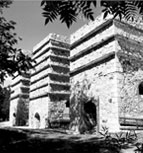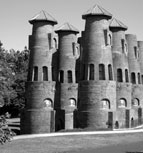 |
||||||
 |
||||||
|
Cement and Lime Home →
|
Recently we've been running a promotional campaign featuring historic kilns preserved throughout North America. Read below to find out more about their role in the history of the cement and lime industry.
The Historic Lime Kilns in Grafton, Wisconsin  Located close to Air Products' industrial gas manufacturing plant in Oak Creek, Wisconsin are three of five original lime kilns built at the turn of the last century. The kilns still stand in Lime Kiln Park in the village of Grafton, Wisconsin. The Milwaukee Falls Lime Company, incorporated in 1890, operated the kilns and an accompanying quarry. Later, the Tews Lime and Cement Co. of Milwaukee bought the operation, which ran until the 1920s. Located close to Air Products' industrial gas manufacturing plant in Oak Creek, Wisconsin are three of five original lime kilns built at the turn of the last century. The kilns still stand in Lime Kiln Park in the village of Grafton, Wisconsin. The Milwaukee Falls Lime Company, incorporated in 1890, operated the kilns and an accompanying quarry. Later, the Tews Lime and Cement Co. of Milwaukee bought the operation, which ran until the 1920s.The kilns stand between 24 and 36 feet tall. They were built of limestone, had vertical shafts of heavy masonry lined with firebrick, and were fueled by immense mounds of cedar and tamarack cordwood. Horse- or mule-drawn cars on rails hauled the limestone from the quarries to the kiln. The lime produced in Grafton was used for whitewashing buildings, conditioning soil, treating animal hides and leather, and for plaster and mortar. As chemical and industrial firms replaced farmers and builders as the main users of lime, the Grafton kilns were shut down, replaced by larger, more efficient kilns in other parts of the country.
Find Out More History of Lime Kiln Park
The Historic Saylor Cement Kilns in Coplay, Pennsylvania  From 1893 to 1904, the nine vertical kilns of the Coplay Cement Company were used to produce portland cement. Built as an improvement over the bottle or dome kiln then in use, the 90-foot-high Schoefer kilns produced a higher quality product on a continuous basis. The kilns were a Danish modification of an upright kiln originally developed in Germany. They were constructed of locally made red brick. At the beginning of the 20th century, the Coplay Cement Company and other cement companies throughout the Lehigh Valley were providing about 75 percent of the nation's needs.
However, the vertical kilns were quickly superseded by rotary kiln technology that required very little labor to operate. They were shut down in 1904 and later donated to Lehigh County. Today, they are still standing in Saylor Park, owned by Lehigh County, and are listed in the National Register of Historic Places. From 1893 to 1904, the nine vertical kilns of the Coplay Cement Company were used to produce portland cement. Built as an improvement over the bottle or dome kiln then in use, the 90-foot-high Schoefer kilns produced a higher quality product on a continuous basis. The kilns were a Danish modification of an upright kiln originally developed in Germany. They were constructed of locally made red brick. At the beginning of the 20th century, the Coplay Cement Company and other cement companies throughout the Lehigh Valley were providing about 75 percent of the nation's needs.
However, the vertical kilns were quickly superseded by rotary kiln technology that required very little labor to operate. They were shut down in 1904 and later donated to Lehigh County. Today, they are still standing in Saylor Park, owned by Lehigh County, and are listed in the National Register of Historic Places.
Find Out More (video courtesy of The Saylor Cement Kilns Preservation Society) History of Cement in the Lehigh Valley |

|
||||